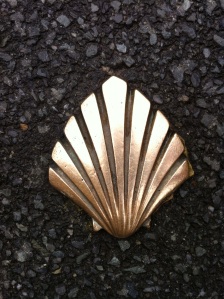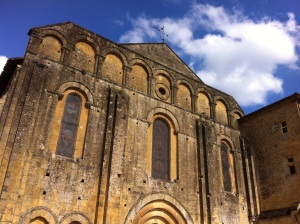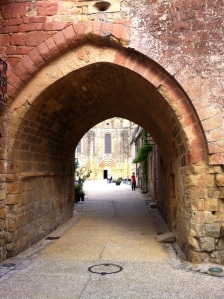Visit: 15th – 18th June 2013, 20th June 2017
The Routes of Santiago de Compostela in France – or, as it is known in English, The Way of St James – is a vast WHS made up of 69 different individual sites scattered all the way across France. The Way of St James has actually been broken down into three different WHSs: in addition to this one, there is an equivalent route inscription in Spain as well as the city of Santiago de Compostela itself. The Way of St James was in medieval times one of the three major pilgrimage routes in Christianity, alongside the Via Francigena (from Canterbury to Rome) and the pilgrimage to Jerusalem.
The sites inscribed in this WHS are generally churches and monasteries that were used as waypoints and stop-offs for pilgrims. It’s a bit unreasonable to have to visit all 69 in order to tick this WHS off, so I am writing this after having seen a representative few. Over time I am sure I will visit more and I will append descriptions to this post. There are 7 other WHSs that are inscribed in their own right, but are also components of this WHS – such as Amiens Cathedral and Mont St Michel.
15th-18th June 2013 – Dordogne
My parents were on a two week break in France, driving their new van – a converted VW T5 – and staying in campsites and Aires along the way. I found some Ryanair flights for about £50 return and got myself down to the Dordogne for 4 days. There isn’t room for three in the van, so here is my accommodation!
I flew from Bristol to Bergerac on the Saturday, arriving to sunny weather in some contrast to the rain back home. We got straight on the road and headed to Saint-Avit-Sénieur – a tiny village that is home to an 11th Century church. Here is one of the outbuildings.
This is a view inside the ruins of the abbey. It was still in use, with some locals playing boules and kids having a mini disco!
That same evening we drove on to nearby Cadouin, where there is an abbey dating back to 1115.
Here you can see the abbey through the one remaining original town gate.
I bought an avocado and some tomatoes from the first of an almost infinite amount of shops that specialise in foix gras down there. Every restaurant we went to seemed to have its menu comprising of at least 2/3rds foix gras-related dishes. I didn’t eat any, but I did have duck meat for dinner on each of the three nights we ate out.
Sunday we went to see the cave art of the Vézère valley, which I’m going to cover in the next post. On Monday we drove an hour or so north to Périgueux – the capital of the Dordogne – to see the third church of the trip. Well, this one is actually a cathedral:
The Cathédral St-Front, as it is known, is striking. But it is not to everyone’s taste, as our guidebook made clear:
Unfortunately, it’s no elegance, having suffered from the zealous attentions of the purist nineteenth-century restorer Abadie, well known for the white elephant of the Sacré-Cœur in Paris. The result is too white, too new, too regular, and the roof is spiked around with ill-proportioned nipple-like projections serving no distinct purpose; “a great example of how not to restore”, Freda White tartly featured in her classic travelogue, Three Rivers of France.
Nevertheless, it is a grand building, and ornately detailed inside. To be honest, a lot of the Christian imagery is wasted on me at the moment, but I’ve ordered a DVD “The History of Christianity” so I can better understand the meaning of the artifacts, paintings and architecture of the churches I visit.
After Périgueux we headed northwards again, and happened upon a wonderful medieval town called Brantôme. It had been raining heavily, but when we arrived in Brantôme it had stopped and the moisture was heavy in the air. The town is surrounded by waterworks and cliffs abut the town’s old abbey (not a part of the WHS, but founded in 769 by Charlemagne himself according to legend).
We had a delicious meal that evening in Brantôme, and my Dad shook the hand of the chef, such was his enjoyment of it.
On the final day of my trip we drove the two hours or so north-east toward Limoges. To the east of Limoges is a town on a hill called Saint-Léonard-de-Noblat, where the eponymous church is named for a 6th Century saint known for freeing prisoners.
The Church is definitely the focal point of this town. Its architecture is described as ‘Romanesque’. You can see below the high roof and the light that comes pouring in.
It was outside this church that we photographed the symbol you can see at the top of this post. This is the symbol that pilgrims used to recognise a place that would welcome them on their way to Spain. And here is a map of the four churches we visited on this WHS (I will update as I visit more).
And after this, it was time for me to head to the airport for my flight back from Limoges.
Maps generated by the Great Circle Mapper – copyright © Karl L. Swartz.
20th June 2017 – Paris
Four years passed before I visited another point on this WHS. On a flying visit to Paris in June 2017 I walked from Châtelet – Les Halles to the Île de la Cité via the Saint-Jacques Tower in the 4th arrondissement. The tower is all that remains of a church that was destroyed in the French Revolution, and is in the Flamboyant Gothic style. Whilst I didn’t go inside (it was closed and I had little time) I enjoyed seeing this tower. I’ve seen a number of interesting French and Belgium belfries as part of the Belfry WHS, and I reckon this one ranks with the best of them. After seeing the tower I continued to the cathedral of Notre Dame, which is part of the Paris, Banks of the Seine WHS.














Pingback: • Santiago de Compostela (Old Town) | Tom's World Heritage Site travel blog
Pingback: • The Loire Valley between Sully-sur-Loire and Chalonnes | Tom Livesey's World Heritage Site blog